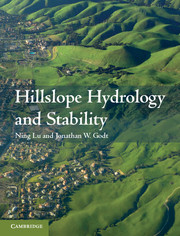Book contents
- Frontmatter
- Contents
- Foreword
- Preface
- List of Symbols
- PART I Introduction and state of the art
- PART II Hillslope hydrology
- 3 Steady infiltration
- 4 Transient infiltration
- Part III Total and effective stress in Hillslopes
- PART IV Hillslope Material properties
- PART V Hillslope stability
- References
- Index
- Plate section
3 - Steady infiltration
from PART II - Hillslope hydrology
Published online by Cambridge University Press: 05 February 2013
- Frontmatter
- Contents
- Foreword
- Preface
- List of Symbols
- PART I Introduction and state of the art
- PART II Hillslope hydrology
- 3 Steady infiltration
- 4 Transient infiltration
- Part III Total and effective stress in Hillslopes
- PART IV Hillslope Material properties
- PART V Hillslope stability
- References
- Index
- Plate section
Summary
Introduction
The mechanism that drives the movement of water, in either the liquid or vapor phase, or as mixture of the two, in hillslopes is the gradient of water potential. For unsaturated hillslope materials, water potential can be cast in either liquid or vapor (gas) form. Several distinct physical mechanisms can contribute to water potential in pore water, namely, gravity, pressure, kinetics, and osmosis. In the near-surface atmospheric and subsurface environments, water potential in the vapor phase directly reflects the number of water molecules in a unit volume of air. This is because the other major gas molecules, such as oxygen and nitrogen, are not involved in phase changes at temperatures typical in these environments, thus the composition of air is relatively constant.
From the second law of thermodynamics (matter moves from high energy places to low energy places), a change in phase from liquid water to vapor in soil pores will occur if a gradient in potential exists. If the total water potential of pore water is greater than the vapor (air) potential, evaporation will occur. By the same thermodynamic equilibrium concept, within each of the phases, if a gradient exists in the total potential, liquid or vapor flow will occur.
- Type
- Chapter
- Information
- Hillslope Hydrology and Stability , pp. 73 - 116Publisher: Cambridge University PressPrint publication year: 2013



